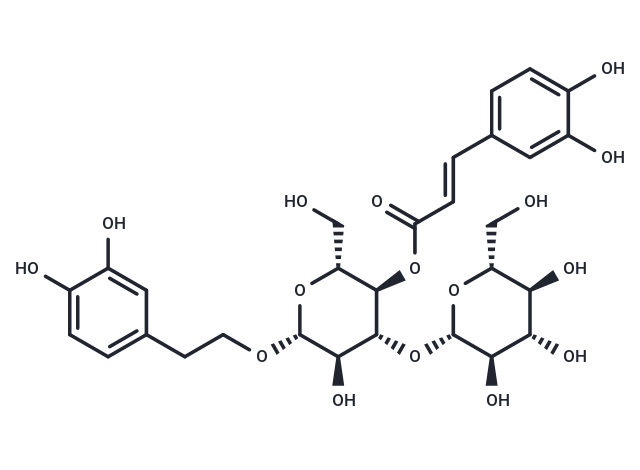Shopping Cart
- Remove All
 Your shopping cart is currently empty
Your shopping cart is currently empty

Plantamajoside (Y0160) has anti-hepatotoxic, anti-inflammatory, antinociceptive activities, improving sexual function and antioxidant activity.

| Pack Size | Price | Availability | Quantity |
|---|---|---|---|
| 20 mg | $100 | In Stock | |
| 1 mL x 10 mM (in DMSO) | $80 | In Stock |
| Description | Plantamajoside (Y0160) has anti-hepatotoxic, anti-inflammatory, antinociceptive activities, improving sexual function and antioxidant activity. |
| Kinase Assay | Ca2+ Fluorescence Assay: SH-EP1 human epithelial cells expressing a variant of theα7 nAChR (α7*) are grown in minimal essential medium (MEM) containing nonessential amino acids supplemented with 10% fetal bovine serum, L-glutamine, 100 U/ml penicillin/streptomycin, 250 ng/mL fungizone, 400 μg/mL hygromycin B, and 800 μg/mL geneticin. α7* is a variant of the human α7 nAChR, with two point mutations in the first transmembrane domain (T230P and C241S) that allow for high functional expression in SH-EP1 cells [Groppi VE, Wolfe ML, Berkenpas MB (2003) U.S. Patent 6,693,172 B1]. Cells are grown in a 37 °C incubator with 6% CO2. Cells are trypsinized and plated in 96-well plates with dark side walls and clear bottoms at a density of 2 × 104 cells/well 2 days before analysis. Cells are loaded with a mixture of Calcium reen-1AM in anhydrous dimethylsulfoxide and 20% pluronic F-127. This reagent is added directly to the growth medium of each well to achieve a final concentration of 2 μM Calcium Green-1 AM. Cells are then incubated in the dye for 1 hour at 37 °C and then washed four times with Mark's modified Earle's balanced salt solution (MMEBSS) composed of the following (inmM): 4 CaCl2, 0.8 MgSO4, 20 NaCl, 5.3 KCl, 5.6 D-glucose, 20 Tris-HEPES, and 120 N-methyl-D-glucamine, pH 7.4. After the fourth cycle, the cells are allowed to incubate at 37 °C for at least 10 minutes. The final volume of MMEBSS in each well is 100 μL and atropine is added to all wells for a final concentration of 1 μM. A fluorometric imaging plate reader (FLIPR; Molecular Devices, Union City, CA) is set up to excite Calcium Green at 488 nm using 500 mW of power and reading fluorescence emission of >525 nm. A 0.5 seconds exposure is used to illuminate each well. Fluorescence is detected using an F-stop set of either 2.0 or 1.2. After 30 seconds of baseline recording, test compounds are added to each well of a 96-well plate in 50 μL of a 3 × stock.In each experiment, four wells are used as vehicle (0.2% DMSO) controls. |
| Alias | Y0160, C10485 |
| Molecular Weight | 640.59 |
| Formula | C29H36O16 |
| Cas No. | 104777-68-6 |
| Smiles | OC[C@H]1O[C@@H](O[C@@H]2[C@@H](O)[C@H](OCCc3ccc(O)c(O)c3)O[C@H](CO)[C@H]2OC(=O)\C=C\c2ccc(O)c(O)c2)[C@H](O)[C@@H](O)[C@@H]1O |
| Relative Density. | 1.66g/cm3 |
| Storage | Powder: -20°C for 3 years | In solvent: -80°C for 1 year | Shipping with blue ice. | |||||||||||||||||||||||||||||||||||
| Solubility Information | DMSO: 91 mg/mL (142.06 mM), Sonication is recommended. Pyridine, Methanol, Ethanol, etc.: Soluble | |||||||||||||||||||||||||||||||||||
Solution Preparation Table | ||||||||||||||||||||||||||||||||||||
DMSO
| ||||||||||||||||||||||||||||||||||||

Copyright © 2015-2025 TargetMol Chemicals Inc. All Rights Reserved.